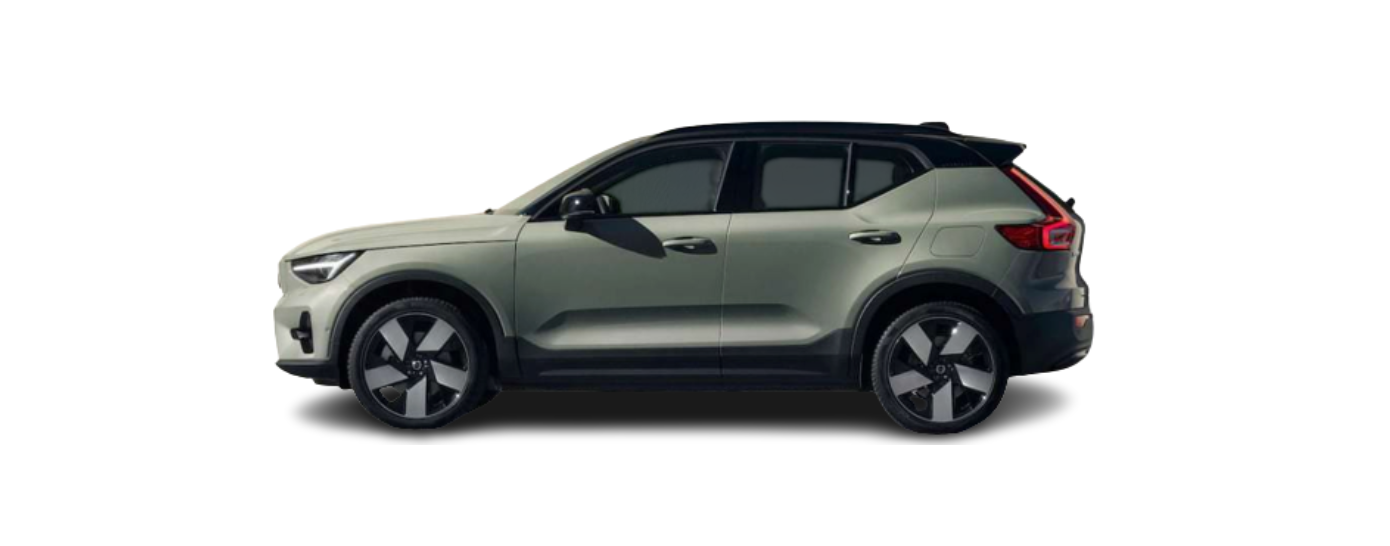2023 Volvo XC40 Recharge Pure Electric Assistance at risk of Collision
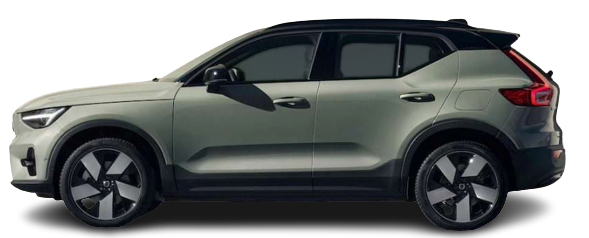
Assistance at risk of collision
Assistance at risk of collision can assist the driver to avoid or mitigate a collision with a warning, automatic braking, and steering assistance.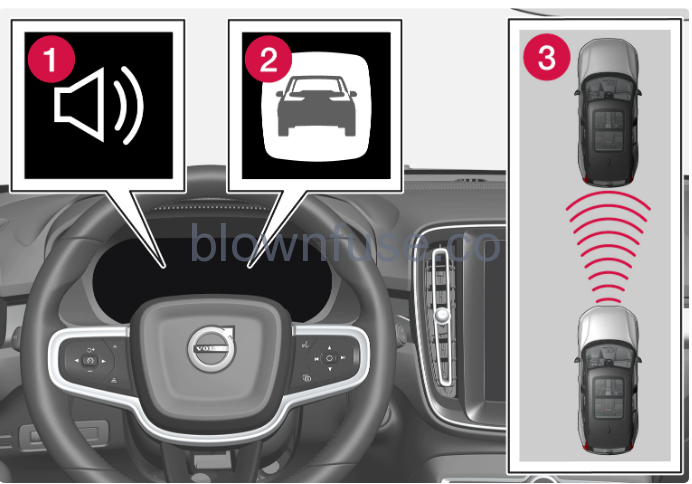
- Audio and symbol for collision warning
- Acoustic signal in the event of a risk of collision
- Warning signal in the event of a risk of collision
- Distance measurement with the camera and radar units
- The driver or passengers are not normally aware of the function – it only intervenes in a situation where a collision is immediately imminent.
- The function can help the driver to avoid a collision when driving in queues, e.g. when changes in the traffic ahead, combined with a lapse in attention, could lead to an incident. The function then activates a short,
- sharp braking procedure, normally stopping the car just behind the vehicle in front.
- The function cannot be deactivated but is always activated.
Subfunctions
Assistance at risk of collision can perform the following steps if necessary:
- Collision warning
- Assisted braking
- Automatic braking
- Steering assistance
Step 1 – Collision Warning
If there is a risk of collision with a pedestrian, cyclist, large animal, or a vehicle then the driver’s attention is alerted to it by means of a visual, acoustic, and brake pulse warning. There is no brake pulse warning in the event of sudden driver braking or acceleration. The brake pulse frequency varies according to the car’s speed.
Step 2 – Assisted braking
Assisted braking reinforces the driver’s braking action if the system considers that the braking is not sufficient to avoid a collision.
Step 3 – Automatic braking
If the driver has not started to take evasive action and the risk of collision is imminent then the automatic braking function is deployed – this takes place irrespective of whether or not the driver brakes. Braking then takes place with full brake force in order to reduce collision speed, or with limited brake force if it is sufficient to avoid a collision. The seatbelt tensioner can be activated in connection with the engagement of the automatic brake function. The function is designed to be activated as late as possible in order to avoid unnecessary intervention. Automatic braking takes place only after or at the same time as the collision warning. When brake assistance has prevented a collision with a stationary object, the car remains stationary in anticipation of positive action by the driver. If the car has been braked to avoid collision with a slower vehicle in front its speed is reduced to match that of the vehicle in front. The driver can always interrupt a braking intervention by firmly depressing the accelerator pedal. When the function is activated and brakes, the brake lights are switched on. The driver display shows a text message advising that the function is or has been active.
Warning
The function must not be used by the driver to change his/her driving style – the driver must not rely on the function alone and allow it to do the braking.
Steering assistance
The function can help the driver reduce the risk of the car leaving its lane unintentionally or colliding with another vehicle or obstacle by actively steering the car back into its lane or swerving. Steering assistance does not occur in sequence but can take place regardless of when the other elements occur. After the automatic engagement, the driver display indicates that this has occurred via a text message.
Note
It is always the driver who decides how much the car should steer – the car can never take command.
Warning
- The function is supplementary driver support intended to facilitate driving and make it safer – it cannot handle all situations in all traffic, weather, and road conditions.
- The driver is advised to read all sections in the Owner’s Manual that relate to this function to learn about factors such as its limitations and what the driver should be aware of before using the system.
- Driver support functions are not a substitute for the driver’s attention and judgment. The driver is always responsible for ensuring the car is driven in a safe manner, at the appropriate speed, at an appropriate distance to other vehicles, and in accordance with current traffic rules and regulations.
Detection of obstacles with assistance at risk of collision
Warnings and break interventions could be late or not occur at all. The driver is always responsible that the vehicle is driven correctly and with a safety distance adapted to the speed.
Vehicles
In order for the function to be able to detect a vehicle in the dark, the vehicle’s front and rear lights must be working and clearly illuminated.
Cyclists

- Examples of what the function interprets as a cyclist — with clear body outline and bicycle outline.
- Good performance requires that the camera and radar units that detect a cyclist must receive the clearest possible information about the body and bicycle outline, requiring the ability to identify the bicycle,
- head, arms, shoulders, legs, upper and lower body plus a normal human pattern of movement.
- If large parts of the cyclist’s body or bicycle are not visible to the function’s camera then the system cannot detect a cyclist.
- For the function to be able to detect a cyclist, he/she must be an adult and riding a bicycle designed for adults.
Warning
The function is supplementary driver support, but it cannot detect all cyclists in all situations and, for example, cannot see:
- partially obscured cyclists.
- cyclists if the background contrast for the cyclists is poor.
- cyclists wearing clothing that obscures the body outline.
- bicycles loaded with large objects.
Pedestrians

- Examples of what the function regards as pedestrians with clear body outlines.
- Good performance requires that the camera and radar units that detect a pedestrian must receive the clearest possible information about the body outline, requiring the ability to identify the head, arms,
- shoulders, legs, upper and lower body plus a normal human pattern of movement.
- In order that it shall be possible to detect a pedestrian, there must be a contrast with the background and this will be affected by such things as clothes, the background, and the weather. With poor contrast,
- the pedestrian may either be detected late or not at all, which may mean that warnings and braking are late or omitted.
- The function can also detect pedestrians in the dark if they are illuminated by the car’s headlamps.
Warning
The function is supplementary driver support, but it cannot detect all pedestrians in all situations and, for example, cannot see:
- partially obscured pedestrians, people in clothing that hides their body contour, or pedestrians shorter than 80 cm (32 tums).
- pedestrians if the background contrast for the pedestrians is poor.
- pedestrians who are carrying larger objects.
Large animals

- Examples of what the function interprets as large animals – standing still or walking slowly and with clear body outlines.
- Good performance requires that the system function that detects a large animal (e.g. elk and horse) must receive the clearest possible information about the body outline, requiring the ability to identify the
- animal directly from the side in combination with what is a normal pattern of movement for the animal.
- If parts of the animal’s body are not visible to the function’s camera then the system cannot detect the animal.
- The function can also detect large animals in the dark if they are illuminated by the car’s headlamps.
Warning
The function is supplementary driver support, but it cannot detect all large animals in all situations and, for example, cannot see:
- partially obscured large animals.
- larger animals are seen from the front or from behind.
- large animals that run or move quickly.
- large animals if the background contrast for the animals is poor.
- small animals such as dogs and cats, for example.
- Warnings and break interventions could be late or not occur at all. The driver is always responsible that the vehicle is driven correctly and with a safety distance adapted to the speed.
Speed reduction option with steering assistance at risk of collision
Vehicles
For a vehicle in front, brake assistance can reduce the speed by up to 60 km/h (37 mph).
Cyclists
For a cyclist, brake assistance can reduce the speed by up to 50 km/h (30 mph).
Pedestrians
For a pedestrian, brake assistance can reduce the speed by up to 45 km/h (28 mph).
Large animals
In the event of a risk of a collision with a large animal, brake assistance can reduce the car’s speed by up to 15 km/h (9 mph). The brake function for large animals is primarily intended to reduce the force of the impact at higher speeds and is most effective at speeds above 70 km/h (43 mph) but less effective at lower speeds.
Symbols and messages for assistance at risk of collision
| Symbol | Message | Specification |
|---|---|---|
 |
Automatic intervention Collision Avoidance
|
When the function is activated, a message is shown to the driver indicating that the system has been activated. |
 |
Collision Avoidance system unavailable | The system is temporarily out of order or is working with reduced performance. |
 |
Collision Avoidance Reduced functionality Service required | The system does not function as it should. Contacting a workshop. |
 |
Windscreen sensor blocked See Owner’s manual | The ability of the camera to scan the roadway in front of the car is reduced. |
A text message can be cleared by briefly pressing the ![]() button, located in the center of the steering wheel’s right-hand keypad.
button, located in the center of the steering wheel’s right-hand keypad.
If a message remains, contact a workshop – an authorized Volvo workshop is recommended.
Limitations for assistance at risk of collision
Limitations for brake assistance
Extra equipment
Low-hanging objects, e.g. a flag/pennant for projecting load, or accessories such as auxiliary lamps and bull bars that are higher than the car bonnet limit the function since they may obstruct the camera or radar unit.
Skidding
On slippery road surfaces, the braking distance is extended, which may reduce the capacity of the function to avoid a collision. In such situations, the anti-lock brakes and the stability control ESC are designed to give the best possible braking force with maintained stability.
Low speed
The function is not activated at very low speeds – below 4 km/h (3 mph) – and the system, therefore, does not intervene in situations where your car is approaching a vehicle ahead very slowly, e.g. when parking.
Active driver
Driver commands are always prioritized. The function does not intervene in situations where the driver is steering and accelerating in a decisive manner, even if a collision is unavoidable. Active and aware driving behavior can therefore delay a collision warning and intervention in order to minimize unnecessary warnings.
Limitations for steering assistance
In certain situations the function may have limited functionality and fail to intervene in the following cases, for example:
- for small vehicles, such as motorcycles
- if the majority of the car has moved into the adjacent lane
- on roads/in lanes with unclear or non-existent lane markings
- outside the speed range of 60-140 km/h (37-87 mph)
- as the steering servo for speed-dependent steering wheel resistance is working at reduced power – e.g. when cooling due to overheating.
Other demanding situations can include:
- road works
- winter road conditions
- narrow roads
- poor road surface
- a very “sporty” driving style
- poor weather with reduced visibility.
In these demanding situations, the function may have difficulty helping the driver correctly.
Important warnings
The driver supports only warn of obstacles that their radar unit has detected – hence a warning may not be given, or it may be given with a certain delay.
- Never wait for a warning or intervention. Apply the brakes when the situation requires.
- Automatic braking can prevent a collision or reduce collision speed, but to ensure full brake performance the driver should always depress the brake pedal – even when the car brakes automatically.
- The warning and steering assistance are only activated if there is a high risk of collision – you must therefore never wait for a collision warning or for the function to intervene.
- The function does not activate any automatic brake interventions in the event of heavy acceleration.
- Warnings and brake interventions could be implemented late or not at all if a traffic situation or external influences mean that the camera and radar units cannot detect pedestrians, cyclists, large animals, or vehicles correctly.
- For vehicles to be detected at night, their headlamps and rear lamp cluster must be switched on and shining clearly.
- Warnings for stationary and slow-moving vehicles, as well as large animals, may be disengaged due to darkness or poor visibility.
- Warnings and brake interventions for pedestrians and cyclists are deactivated at vehicle speeds exceeding 80 km/h (50 mph).
- The system can provide effective warnings and brake interventions as long as the relative speed is below 50 km/h (30 mph).
- For stationary or slow-moving vehicles, warnings and brake interventions are effective at vehicle speeds up to 70 km/h (43 mph).
- The speed reduction for large animals is less than 15 km/h (9 mph) and can be achieved at vehicle speeds above 70 km/h (43 mph). The warning and brake intervention for large animals is less effective at lower speeds.
- Do not place, stick or mount anything on the outside or inside of the windscreen in front of or around the camera unit – this can interfere with camera-dependent functions.
- Objects, snow, ice, or dirt in the area of the camera and radar units may reduce their functionality, fully deactivate them or give incorrect function responses.
This function uses the car’s camera and radar units, which have certain general limitations.
Maintenance of driver support components must only be performed at a workshop – an authorized Volvo workshop is recommended.
Assistance at risk of collision in crossing traffic
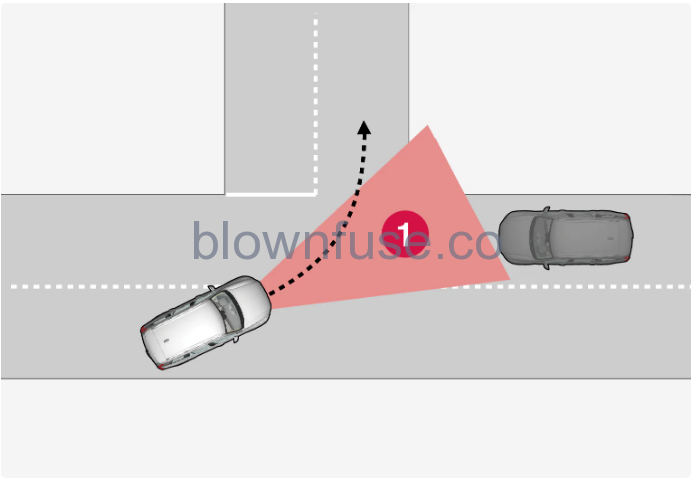
For the function to detect an oncoming vehicle on a collision course, the oncoming vehicle must first enter the sector in which the function can analyze the situation.
- your car’s speed must be at least 4 km/h (3 mph).
- your car must turn to the left in markets with right-hand traffic (or to the right in left-hand traffic).
- the oncoming vehicle must have its headlamps switched on.
The function may have difficulty in assisting the driver if, for example:
- there are slippery driving conditions and stability control intervenes.
- an oncoming vehicle is detected too late.
- an oncoming vehicle is obscured by something.
- the oncoming vehicle has headlamps switched off.
- the oncoming vehicle drives in an unpredictable manner, for example, abruptly changing lanes at a late stage.
Warnings and steering assistance due to an impending collision with an oncoming vehicle always come very late.
This function uses the car’s camera and radar units, which have certain general limitations.
Collision Avoidance to help avoid impact with a vehicle in the driver’s blind spot
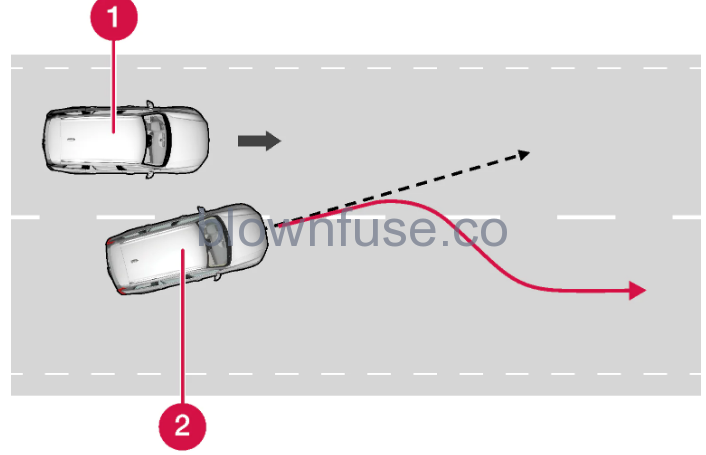 The function can assist by steering the car back to its own lane.
The function can assist by steering the car back to its own lane.- Another vehicle in the blind spot
- Your car
- The function can even assist if the driver intentionally changes lanes using direction indicators without noticing that another vehicle is approaching.
- The function is active within the speed range of 60-140 km/h (37-87 mph) on roads with clearly visible lane markings/lines.
- The lamps in the door mirrors flash at the same time as the steering input. An acoustic signal can also be heard.
- When the function intervenes, a message is shown in the driver display.
Warnings and steering assistance due to an impending collision always come very late.
Note
This function uses the car’s camera and radar units, which have certain general limitations.
Assistance at risk of run-off
The function has two levels for intervention:
- Steering assistance only
- Steering assistance with brake intervention
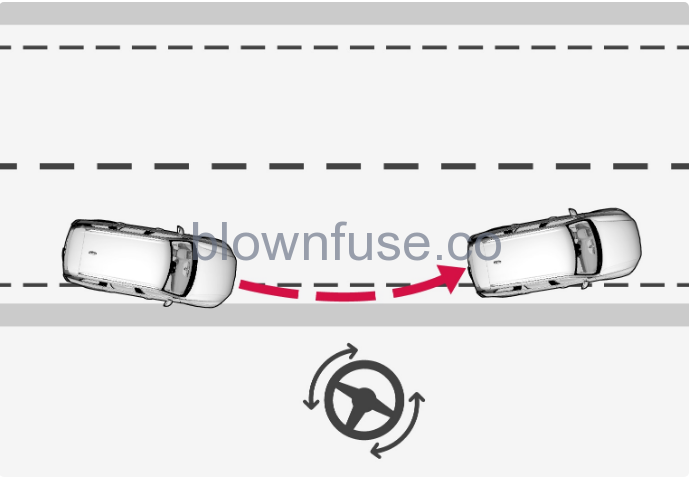 Intervention with steering assistance
Intervention with steering assistance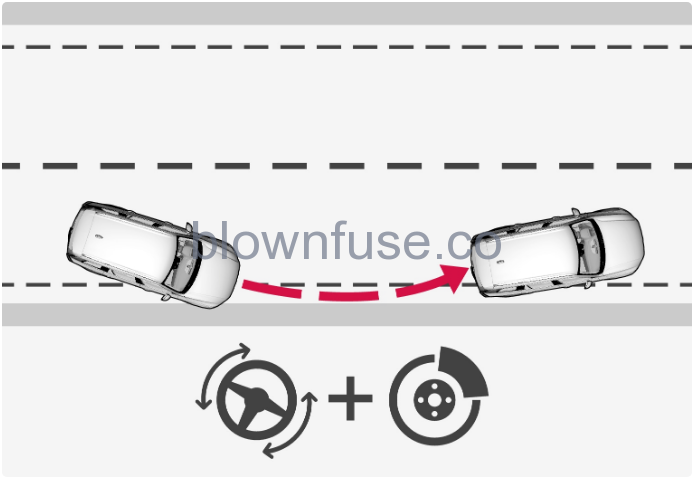 Intervention with steering assistance and brakingBrake intervention helps in situations where steering assistance alone is not sufficient. The brake force is adapted automatically depending on the situation at the time of road run-off. The function is active within the speed range of 65-140 km/h (40-87 mph) on roads with clearly visible lane markings/lines. The car’s camera unit scans the edges of the road and the painted lane markings. If the car is about to leave the side of the road, the car can be steered back onto the road and if the steering intervention is not enough to avoid a run-off, the brakes are also activated. However, there is no intervention from the function with either steering assistance or brake intervention if the direction indicators are used. If the function detects that the driver is actively driving the car, activation of the function will be delayed. When the function intervenes, a message is shown in the driver display.
Intervention with steering assistance and brakingBrake intervention helps in situations where steering assistance alone is not sufficient. The brake force is adapted automatically depending on the situation at the time of road run-off. The function is active within the speed range of 65-140 km/h (40-87 mph) on roads with clearly visible lane markings/lines. The car’s camera unit scans the edges of the road and the painted lane markings. If the car is about to leave the side of the road, the car can be steered back onto the road and if the steering intervention is not enough to avoid a run-off, the brakes are also activated. However, there is no intervention from the function with either steering assistance or brake intervention if the direction indicators are used. If the function detects that the driver is actively driving the car, activation of the function will be delayed. When the function intervenes, a message is shown in the driver display.Warning
This function uses the car’s camera and radar units, which have certain general limitations.
